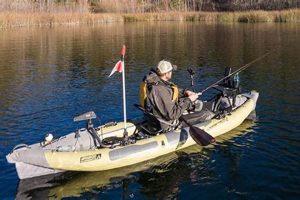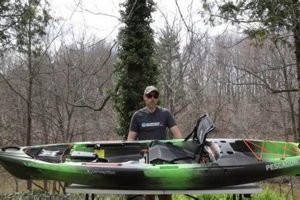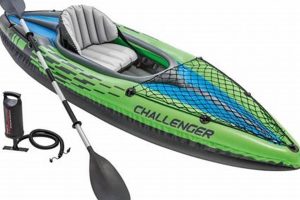Optimizing a kayak for fishing involves strategic additions and alterations designed to improve angler efficiency, comfort, and safety. These modifications can range from simple rod holders and anchor systems to more complex additions like fish finders and pedal drives. A well-equipped fishing kayak offers a stable and versatile platform for accessing diverse fishing locations.
Enhanced angling experiences result from a thoughtfully customized kayak. Increased stability, improved organization, and readily accessible tools contribute to a more productive and enjoyable time on the water. While traditional fishing methods remain popular, kayak fishing’s accessibility and adaptability have broadened its appeal, leading to innovative solutions for customizing watercraft. This growth has spurred significant advancements in kayak design and specialized fishing accessories.
This article will delve into specific modifications, examining popular choices and offering guidance on selecting upgrades based on individual fishing styles and target species. Further exploration will cover installation techniques, maintenance requirements, and the impact of modifications on kayak performance and safety.
Tips for Optimizing Kayak Fishing Setups
Strategic modifications enhance fishing kayak functionality and performance. The following tips provide guidance for effective upgrades.
Tip 1: Prioritize Stability: Kayak stability is paramount, especially when fishing. Outriggers or wider hulls significantly improve stability, reducing the risk of capsizing, particularly in challenging conditions or when reeling in a substantial catch.
Tip 2: Optimize Storage: Efficient storage solutions maximize space and keep essential gear organized and readily accessible. Tackle boxes, crates, and dry bags secured with bungee cords or mounted within recessed compartments contribute to a clutter-free and efficient fishing platform.
Tip 3: Secure Rod Holders: Well-placed rod holders free hands for other tasks, such as paddling, landing fish, or adjusting tackle. Flush-mounted or adjustable rod holders accommodate various fishing styles and rod lengths.
Tip 4: Enhance Visibility: Flags, lights, and reflective tape improve visibility, particularly in low-light conditions or crowded waterways. Increased visibility enhances safety, alerting other boaters to the kayak’s presence.
Tip 5: Consider a Fish Finder: Fish finders provide valuable underwater insights, revealing fish locations, depth contours, and bottom structure. Portable or permanently mounted units enhance angling efficiency and increase the chances of a successful catch.
Tip 6: Install an Anchor System: Anchor systems allow anglers to maintain position in desired fishing locations, preventing drift and maximizing fishing time in productive spots. Anchor trolleys offer further control, enabling precise positioning within a chosen area.
Tip 7: Integrate a Propulsion System: Pedal drives or trolling motors free up hands for fishing, allowing anglers to cover more water and maintain precise positioning without paddling. These systems offer significant advantages in areas with currents or covering larger bodies of water.
By incorporating these enhancements, anglers can transform their kayaks into highly effective fishing platforms, maximizing comfort, efficiency, and overall fishing success. A carefully planned setup directly contributes to a more productive and enjoyable experience on the water.
This information provides a solid foundation for choosing appropriate modifications. Further research into specific products and installation techniques is recommended before implementing any changes.
1. Stability Enhancements
Stability is paramount in kayak fishing, directly impacting safety and angling effectiveness. Modifications that enhance stability are crucial, particularly when navigating challenging conditions, dealing with larger fish, or standing to cast. These enhancements allow anglers to focus on fishing rather than maintaining balance.
- Outriggers:
Outriggers provide exceptional stability by extending pontoons outward from the kayak’s hull. This increased lateral support significantly reduces the risk of tipping, especially in rough water or when leaning over the side. Deployable and removable outriggers offer versatility for various fishing environments.
- Wider Hull Designs:
Kayaks with wider hulls offer inherent stability due to their increased beam (width). While potentially sacrificing some maneuverability, the added stability proves invaluable for fishing, allowing for more confident movement and reducing the likelihood of capsizing.
- Stabilizer Fins:
Stabilizer fins, often retractable, create additional drag in the water, enhancing stability and tracking. These fins can improve performance in windy conditions and reduce rocking, providing a more stable platform for fishing.
- Weight Distribution:
Proper weight distribution within the kayak plays a critical role in stability. Distributing gear evenly and storing heavier items lower in the hull lowers the center of gravity, minimizing the risk of tipping. Careful consideration of weight placement significantly impacts stability and performance.
By prioritizing stability enhancements, anglers create a safer and more effective fishing platform. These modifications contribute significantly to overall performance and enjoyment on the water, enabling anglers to focus on fishing with confidence and peace of mind.
2. Efficient Storage Solutions
Efficient storage solutions are integral to optimal kayak fishing setups. Limited space necessitates thoughtful organization to maximize efficiency and maintain a clutter-free environment. A well-organized kayak allows anglers to focus on fishing rather than searching for misplaced gear. Tangled lines, lost lures, and inaccessible tools detract from the fishing experience and compromise safety. Strategic storage solutions directly address these challenges, ensuring essential equipment remains readily accessible while maximizing available space.
Several storage modifications enhance kayak fishing functionality. Tackle boxes secured within recessed compartments provide organized storage for lures, hooks, and other small items. Milk crates, often customized with rod holders and accessory mounts, offer versatile storage options for larger gear. Dry bags protect sensitive electronics and personal items from water damage. Bungee cords secure loose items, preventing loss overboard. Rod holders, strategically placed for easy access, keep rods organized and prevent tangling. These solutions, when implemented thoughtfully, create a streamlined and efficient fishing platform, maximizing both space and functionality.
The impact of efficient storage extends beyond mere convenience. A well-organized kayak contributes directly to fishing success and safety. Rapid access to essential gear allows anglers to respond quickly to changing conditions and capitalize on fishing opportunities. A clutter-free environment minimizes the risk of entanglement and tripping hazards, promoting a safe and enjoyable fishing experience. Implementing effective storage solutions transforms a kayak into a well-equipped and highly functional fishing platform, enhancing both performance and enjoyment on the water. Careful planning and selection of appropriate storage modifications are essential for maximizing the benefits of a customized kayak fishing setup.
3. Rod Holder Placement
Strategic rod holder placement is a critical component of optimizing a fishing kayak. Effective placement maximizes fishing efficiency, minimizes interference with paddling and other onboard activities, and contributes significantly to overall safety. Improperly placed rod holders can lead to tangled lines, lost rods, and potentially dangerous situations. Careful consideration of fishing style, target species, and kayak layout is essential for determining optimal rod holder placement.
Anglers targeting larger species, such as offshore game fish, often benefit from angled rod holders positioned towards the stern, facilitating effective fighting techniques. Conversely, kayak anglers fishing in rivers or streams may prefer rod holders positioned closer to the bow for easier maneuverability and line management in moving water. Fly fishermen often utilize specialized rod holders designed to accommodate the unique requirements of fly fishing techniques. Multiple rod holders, strategically placed, allow anglers to employ diverse fishing methods and target different species simultaneously. Flush-mounted rod holders minimize interference with paddling, while adjustable rod holders offer versatility for various fishing scenarios.
The impact of proper rod holder placement extends beyond mere convenience. Efficient rod management directly influences fishing success and safety. Readily accessible rods allow anglers to respond quickly to bites and changing conditions, maximizing opportunities to land fish. Well-secured rods minimize the risk of losing valuable equipment, while preventing entanglement and potential hazards. Rod holder placement is an integral consideration in optimizing a fishing kayak, contributing significantly to an efficient, productive, and safe fishing experience. Careful planning and customization based on individual fishing styles and target species are crucial for maximizing the benefits of strategic rod holder placement.
4. Visibility and Safety Gear
Visibility and safety gear are integral components of best kayak mods for fishing, directly impacting angler well-being and regulatory compliance. Enhanced visibility increases the likelihood of being seen by other boaters, particularly in low-light conditions or congested waterways, mitigating collision risks. Kayaks, being smaller and lower to the water than motorized vessels, are inherently less visible. Therefore, augmenting visibility through modifications becomes crucial for safety. Flags, lights, and reflective tape significantly improve visibility, reducing the potential for accidents. Furthermore, proper safety gear, such as personal flotation devices (PFDs) and whistles, is essential for legal compliance and emergency preparedness. A brightly colored PFD enhances visibility and provides flotation in case of capsizing. A whistle allows anglers to signal for assistance in emergencies. Integrating these elements into kayak modifications reinforces angler safety and promotes responsible boating practices. Neglecting visibility and safety equipment compromises not only personal safety but also the safety of others sharing the waterway.
Consider a scenario where a kayak angler ventures out early morning or late evening. Reduced visibility due to dim lighting increases the risk of collision with other vessels. A kayak equipped with navigation lights and reflective tape significantly improves visibility, alerting other boaters to its presence and reducing the likelihood of accidents. Similarly, in foggy conditions or on overcast days, bright colors and reflective surfaces enhance visibility, further mitigating collision risks. Real-life examples underscore the crucial role visibility plays in averting potentially dangerous situations. Beyond collision avoidance, visibility aids search and rescue operations in emergencies. A brightly colored kayak and PFD make it easier for rescuers to locate an angler in distress. The practical significance of enhanced visibility extends beyond immediate safety concerns, influencing the effectiveness of emergency response efforts.
Prioritizing visibility and safety gear demonstrates a commitment to responsible kayaking practices. This proactive approach mitigates risks, enhances safety, and promotes a positive experience on the water. Integrating visibility enhancements and essential safety equipment into kayak modifications is not merely a recommendation but a fundamental aspect of responsible angling. By equipping kayaks with appropriate visibility and safety gear, anglers contribute to a safer boating environment for themselves and others. This commitment to safety reinforces the broader goal of responsible enjoyment of aquatic environments, ensuring that fishing remains a pleasurable and safe activity.
5. Integrated Propulsion Systems
Integrated propulsion systems represent a significant advancement in kayak fishing modifications, directly impacting angler efficiency and range. These systems, encompassing pedal drives and electric trolling motors, offer hands-free propulsion, allowing anglers to focus on fishing rather than paddling. This advantage proves particularly beneficial in scenarios requiring precise boat control, such as maintaining position in currents or targeting specific structures. Moreover, integrated propulsion expands accessible fishing grounds, enabling anglers to cover greater distances and explore previously unreachable areas. This enhanced mobility translates to increased fishing opportunities and potentially higher catch rates. The impact of these systems extends beyond mere convenience, fundamentally altering how anglers interact with their environment and pursue their quarry.
Consider a scenario where an angler targets fish along a river system. A traditional paddle kayak requires constant paddling to maintain position against the current, diverting attention from fishing. However, a kayak equipped with a pedal drive allows the angler to maintain position effortlessly, freeing hands for casting and retrieving. Similarly, an electric trolling motor enables precise maneuvering around submerged structures or weed beds, optimizing lure presentation and maximizing fishing efficiency. These practical applications illustrate the transformative impact of integrated propulsion systems on kayak fishing. Furthermore, these systems reduce physical exertion, particularly during long fishing trips, allowing anglers to conserve energy and focus on the task at hand. This advantage proves particularly beneficial for anglers with physical limitations or those seeking a less strenuous fishing experience.
Integrating propulsion systems presents certain considerations. Pedal drives, while efficient and quiet, add weight and complexity to the kayak. Electric trolling motors require batteries, adding further weight and necessitating charging. The selection of an appropriate propulsion system depends on individual fishing styles, target species, and budgetary constraints. Careful evaluation of these factors ensures optimal performance and compatibility with the angler’s specific needs. Despite these considerations, the benefits of integrated propulsion systems for kayak fishing are undeniable. These systems enhance efficiency, expand access to fishing grounds, and reduce physical strain, contributing significantly to a more productive and enjoyable angling experience. The integration of these systems represents a significant step forward in kayak fishing technology, empowering anglers to explore new possibilities and maximize their time on the water.
Frequently Asked Questions
Addressing common inquiries regarding kayak fishing modifications clarifies key considerations and facilitates informed decision-making. Understanding the practical implications of various modifications ensures optimal equipment selection and enhances the overall fishing experience.
Question 1: How do modifications affect kayak stability?
Modifications, particularly those impacting weight distribution and hull design, influence kayak stability. Adding weight higher on the kayak raises the center of gravity, potentially decreasing stability. Modifications that broaden the base, such as outriggers, generally enhance stability. Careful consideration of weight distribution and the impact of specific modifications is crucial for maintaining balance and preventing capsizing.
Question 2: Are modifications universally compatible with all kayaks?
Compatibility varies depending on kayak design, construction materials, and specific modification requirements. Certain modifications may require drilling into the hull, potentially compromising structural integrity or manufacturer warranties. Consulting kayak specifications and manufacturer recommendations is essential before implementing any modifications.
Question 3: Do modifications impact kayak performance and maneuverability?
Modifications can influence kayak performance, affecting speed, tracking, and maneuverability. Added weight reduces speed and responsiveness, while certain modifications, like rudder systems, improve tracking. Anglers must consider the trade-offs between desired performance characteristics and the impact of specific modifications.
Question 4: What are the maintenance requirements for modified kayaks?
Modifications introduce additional maintenance considerations. Moving parts, such as rudder systems and pedal drives, require regular lubrication and inspection. Electrical components necessitate proper care and charging. Routine maintenance ensures optimal performance and prolongs the lifespan of modifications.
Question 5: Are there legal restrictions regarding kayak modifications?
Regulations regarding kayak modifications vary by jurisdiction. Navigation lights and registration requirements often apply, particularly for kayaks operating in designated waterways. Consulting local boating regulations ensures compliance and avoids potential legal issues.
Question 6: How do I choose the right modifications for my fishing style?
Selecting appropriate modifications requires careful consideration of fishing style, target species, and typical fishing environment. Anglers targeting larger fish in open water may prioritize stability and propulsion systems, while river anglers might focus on maneuverability and anchor systems. Evaluating individual needs and preferences guides effective modification selection.
Careful consideration of these frequently asked questions empowers anglers to make informed decisions regarding kayak modifications. Prioritizing safety, compatibility, and functionality ensures an enhanced fishing experience and promotes responsible enjoyment of the aquatic environment.
The subsequent section will offer concluding remarks and summarize key takeaways for optimizing kayak fishing setups.
Optimizing Kayak Fishing Setups
Strategic kayak modifications demonstrably enhance fishing efficacy and overall experience. Considerations encompassing stability enhancements, efficient storage solutions, rod holder placement, visibility and safety gear, and integrated propulsion systems contribute significantly to a customized and productive fishing platform. Careful evaluation of individual fishing styles, target species, and environmental conditions informs appropriate modification selections. Prioritizing safety, functionality, and compatibility ensures modifications seamlessly integrate with existing kayak configurations, maximizing performance and enjoyment on the water.
Thoughtful customization transforms standard kayaks into highly effective fishing vessels, expanding angling opportunities and promoting responsible engagement with aquatic environments. Continuous exploration of innovative modifications promises further advancements in kayak fishing technology, enhancing angling experiences and fostering a deeper connection with the sport. Investing time and consideration in optimizing kayak setups yields substantial rewards, contributing to both immediate fishing success and long-term enjoyment of the pursuit.






